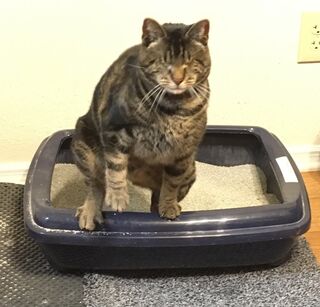Scent
To Pee or Not To Pee: The Feline House Soiling Problem
How to approach a case of feline house soiling and design a treatment plan.
Posted October 1, 2021 Reviewed by Tyler Woods
Key points
- It is very important to rule out physical reasons for undesired elimination in cats.
- Cats may soil the house for a number of behavioral reasons, so finding out the cause of the problem is important.
- Feline house-soiling is treatable by providing a cat-friendly environment, utilizing behavior modification, and using medication when needed.
House-soiling problems are the most common behavioral complaint about cats. If not managed, house-soiling problems are a major driver for rehoming, abandonment, or euthanasia. Feline house-soiling can be categorized into problems related to marking behavior and problems relating to undesirable toileting.
Physical, Behavioral, or Both?
In all behavior cases, it is essential to perform a thorough physical examination—including an orthopedic or neurologic evaluation—and appropriate diagnostics to rule out medical differential diagnoses.
It is imperative to identify the correct offending cat(s), determine the form of house-soiling (i.e., marking vs. toileting, urine vs. feces, or both), and the location and temporal pattern of the house-soiling

Marking vs. Undesirable Toileting
Marking is a normal feline behavior. The goal of marking is inter-cat communication using olfactory and visual cues to avoid conflict. Typical features of urine marking include a standing posture with raised and twitching tail and a deposit of a small volume of urine, usually on a vertical surface.
Undesirable toileting can occur in response to dissatisfaction with the litter box experience or elimination preference. The litter box might not meet the cat’s needs or preference regarding the number of boxes, size, type, location, litter substrate, or cleanliness. Typical features of undesirable toileting include a normal elimination posture, usually near the vicinity of a litter box, and voidance of the bladder.
Treatment Tips
Meeting each cat’s environmental needs is the first line of behavioral treatment. All cats' needs should be met by implementing a healthy feline environment.
The goal of management is to prevent repeated undesirable behavior without instilling fear. Proactive prevention, providing a sense of safety, and the removal of contributing triggers are the essential components of environmental management. Prevention of undesirable behaviors includes avoiding access to previously soiled sites and cleaning soiled sites to remove residual olfactory cues.
Behavioral modification aims to change the cat’s underlying emotional response to either increase or decrease the frequency or expression of behaviors. When behaviors are rewarded, they are repeated and can increase in frequency. The goal is to reinforce the desired behavior (use of the litter box) and decrease the perceived reinforcement of the undesirable behavior (house-soiling). Punishment techniques have a high risk of inducing fear and anxiety, exacerbating the primary motivation for most house-soiling diagnoses.
Medications and adjunctive therapies can include pheromones, nutraceuticals, diets, and pharmaceuticals. The goal of medications and adjunctive therapies is to decrease anxiety that may contribute to the motivation for house-soiling. By decreasing anxiety, the rest of the comprehensive plan (management and modification) can be more effective and hasten progress.
For more in-depth information about feline house-soiling and how to treat it, check out Dr. Pankratz’s ACVB Webinar on Feline Housesoiling.

Dr. Pankratz graduated with her veterinary degree from the University of Wisconsin – Madison in 2014 and pursued a small animal rotating internship in New York. She completed her behavioral medicine residency program at North Carolina State University and became board certified by the American College of Veterinary Behaviorists in 2018. She stayed on at NC State for her fellowship and as a clinical instructor before joining the Animal Behavior Clinic in Portland, OR in 2019. For her research on the use of behavioral medication to improve the welfare of cats, she was awarded the RK Anderson ACVB Resident Award and JFMS Resident Best Paper Award


